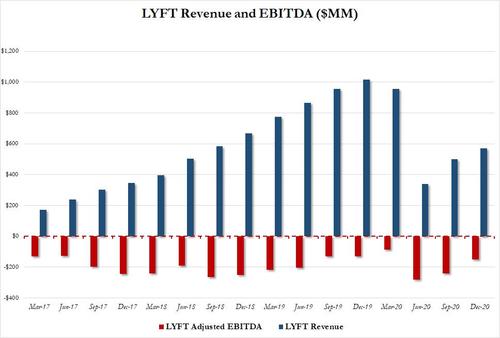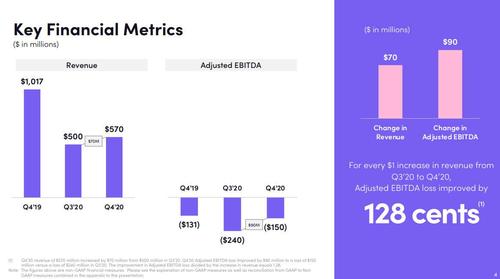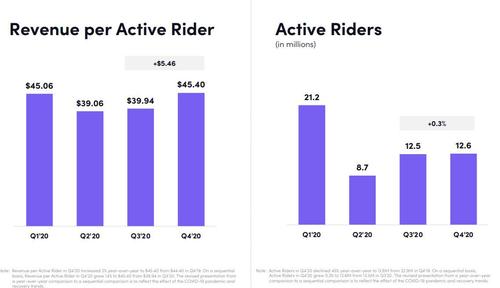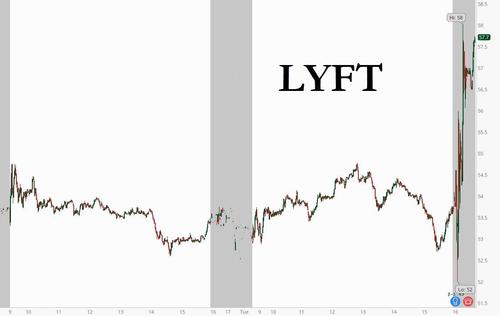Lyft Jumps Despite Continued Customer Plunge As Revenue Per Rider Jumps
Despite a continued plunge in total ridership, with the company reporting a whopping 51% drop in January rides Y/Y…
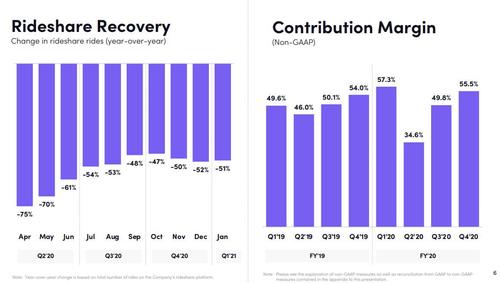 … Lyft inched closer to break-even as the amount of revenue it gets from each customer and its contribution margin both rose helping lift revenue and EBITDA both rebound sequentially (if slide on an annual basis).
… Lyft inched closer to break-even as the amount of revenue it gets from each customer and its contribution margin both rose helping lift revenue and EBITDA both rebound sequentially (if slide on an annual basis).
The pure-play ride-hailing company, which unlike Uber does not have an ancillary delivery service which offers a revenue buffer during times or ridership stress (like now), reported adjusted EBITDA of $150 million in the fourth quarter, worse than a year earlier but better than the ($182.7) consensus estimate.
Here are the main highlights from Q4:
- Revenue $569.9 million, better than exp. $561.2 million
- Active riders 12.6 million, missing the exp. of 13.3 million
- Adjusted net loss $185.3 million, better than exp. $224.7 million
- Adjusted EBITDA loss $150.0 million, better than the exp. $182.7 million
Yet while this mixed picture would hardly sparked confidence in the stock, John Zimmer, the co-founder and president, said company-wide cost cuts guarantee Lyft will “absolutely” turn a quarterly adjusted profit this year. However, he declined to provide a forecast for the first quarter, citing uncertainty around vaccine distribution.
In an interview with Bloomberg, the company said it had exceeded goals to reduce spending last year and is focused on going further this year. “We were targeting $300 million of annualized savings, and we came out with $360 million.”
As a result of the cost cutting, revenue per rider increased 2.3% to $45.40 in the period that ended Dec. 31. Analysts expected $41.99; That said, revenue declined 44% to $569.9 million in the quarter from a year earlier, as total active riders declined 45% to about 12.6 million, missing estimates of 13.3 million.
Since Lyft does not have a delivery business unlike Uber, the company struck delivery partnerships with Grubhub for food and Blue Cross Blue Shield for pharmaceuticals but has been unable to keep pace with Uber which shifted its own business toward delivery. In December, Lyft lowered its outlook.
Finally, looking at the balance sheet, Lyft ended the year with more current assets than analysts expected, reporting $2.6 billion, including cash, short-term investments and prepaid expenses.
In response to the earnings, investors were happy to overlook the ridership miss and instead focused on the jump in revenue per user and the promise of profitability, sending the stock nearly 10% higher after hours.
Tyler Durden
Tue, 02/09/2021 – 16:46![]()
Zero Hedge’s mission is to widen the scope of financial, economic and political information available to the professional investing public, to skeptically examine and, where necessary, attack the flaccid institution that financial journalism has become, to liberate oppressed knowledge, to provide analysis uninhibited by political constraint and to facilitate information’s unending quest for freedom. Visit https://www.zerohedge.com
